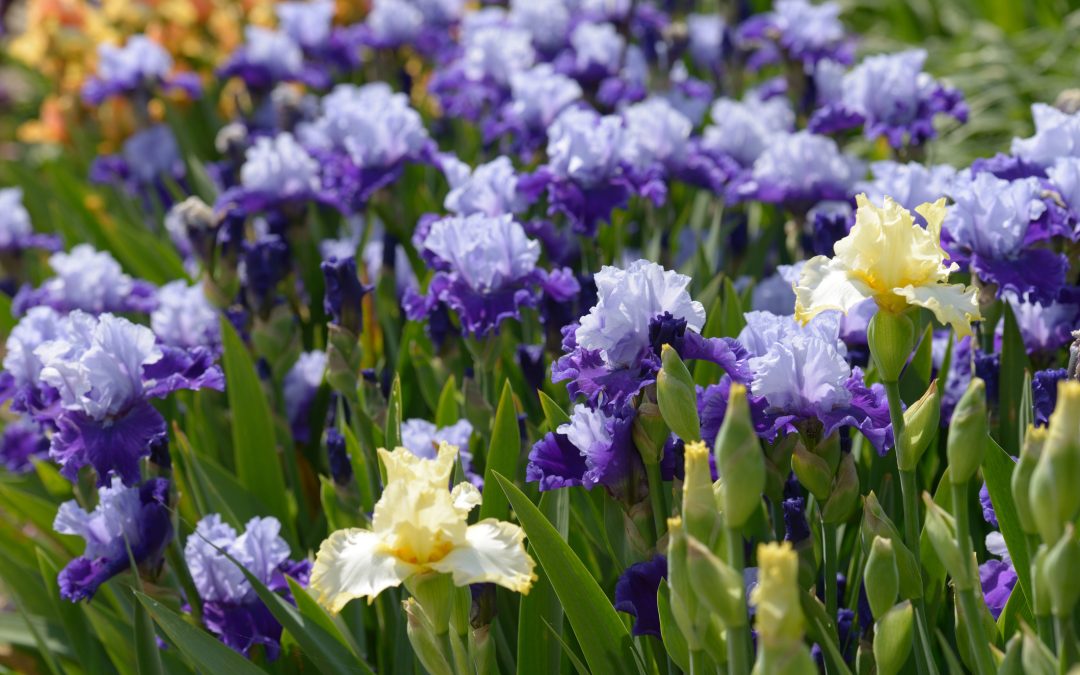When the irises bloom, I am reminded of the piano recitals of my youth. The recitals were always in late spring, usually May. Adorning the stage and adjacent to the piano awaiting nervous young musical prodigies was a wicker basket filled with my grandmother’s irises. In small towns in Mississippi, before there were florists, garden flowers supplied by family and friends filled church sanctuaries, decorated homes for bridal teas and showers, and lent fragrance and color to all special occasions, even piano recitals. The flowers, of course, were seasonal and homegrown. Irises are beloved by Mississippi gardeners, but these gorgeous flowers have been admired and cherished since ancient times. This flower’s name is from the Greek word for “rainbow,” and the Greek god Iris was the messenger of the gods. Egyptian kings were quite taken with this flower, and drawings of it can be found in ancient palaces. During the Middle Ages, the iris or fleur-de-lis became the symbol of France. One of the world’s most expensive paintings ever sold was “Irises” painted by Vincent van Gogh, and Claude Monet grew them in his garden in Giverny, France.
Where to Plant
Most irises need at least six hours of sun a day and can thrive in full sun, even in the heat of a Mississippi summer. The exception to this is the native Dwarf Crested Iris, which is a woodland species and will grow in dappled shade.
Water Requirements
Bearded irises should be watered after transplanting and during extreme drought, but too much water can lead to rhizome rot. Bearded irises can survive beyond the sprinkler system. Irises should never be planted in wet places, unless they are flag irises, which are well adapted for wetlands.
Soil Conditions
Irises should be planted in well-drained soil but will grow in less than perfect soils. Irises do well in raised beds and grow well on slopes. Irises do not perform well in heavy clay soils.
Fertilization
When it comes to fertilization, less is better. Avoid high nitrogen fertilizers. Bone meal and a well-balanced fertilizer applied in spring and a month after they bloom should be adequate.
How to Plant
Every three to four years, the clumps of irises should be divided to keep them blooming. Irises have thick, fleshy roots called rhizomes. It is best to dig them up with a spade and divide the rhizomes by hand or with a sharp knife. The iris rhizomes should be planted just barely below the surface of the ground and about 12 inches apart to insure good air circulation. The tops of the rhizomes should be almost visible. The roots should be spread out. It is a mistake to plant iris rhizomes too deeply. This is one plant that does not need mulch.
When to Plant
The best time to divide and plant irises is in late summer through fall. Most gardeners in Mississippi start in late June or July. Yes, it is hot and spring fever has long since waned, but to keep those bearded irises blooming, one must sweat a little. But that only has to be done every three or four years. Irises, once established, are very low maintenance.
The iris is one of nature’s most beautiful, exotic flowers, and there are a myriad of varieties that bloom from early spring until summer. In Mississippi there are several native species of iris. Two of my favorites are Dwarf Crested iris (Iris cristata) and Copper Iris (Iris fulva). Both of these irises bloom in early spring. Iris cristata is pale lavender and strikingly lovely and grows in woodlands. Iris fulva is an unusual copper color and is indigenous to the Mississippi Delta. Both of these wildflowers adapt well to traditional gardens, and many garden catalogs and local nurseries carry these native iris plants.
But of course the irises that are most familiar and sought after are the bearded irises. Nowadays, there are hundreds of varieties or hybrids, and they come in a veritable rainbow of colors. With their ruffled petals and contrasting “beards,” gardeners everywhere covet these flowers.
Irises are hardy plants and require minimal care. I have seen them growing in Monet’s famous garden in Giverny, and these are the same irises my grandmother grew in Mississippi. If Monet and my grandmother can grow irises, so can you.
The iris is a flower that just keeps on giving. When you run out of room in your flowerbed and along the sidewalk and out by the mailbox, then you pass them along to your neighbors, family, and friends. In years to come, the name of the iris variety may fade, but the person who bestowed the iris as a gift will be long remembered.
Irises can be purchased from garden centers, catalogs, and plant sales sponsored by Iris Societies, but if ever there was a true pass-along plant, it is the iris. Most of the irises in my garden were given by friends, and, of course, some are from my grandmother’s garden. When the irises bloom, I am transported to a long-ago time. I cut a few to display in a vase, play Beethoven’s “Fur Elise” on the piano and remember my grandmother. Flowers, especially irises, evoke memories.





